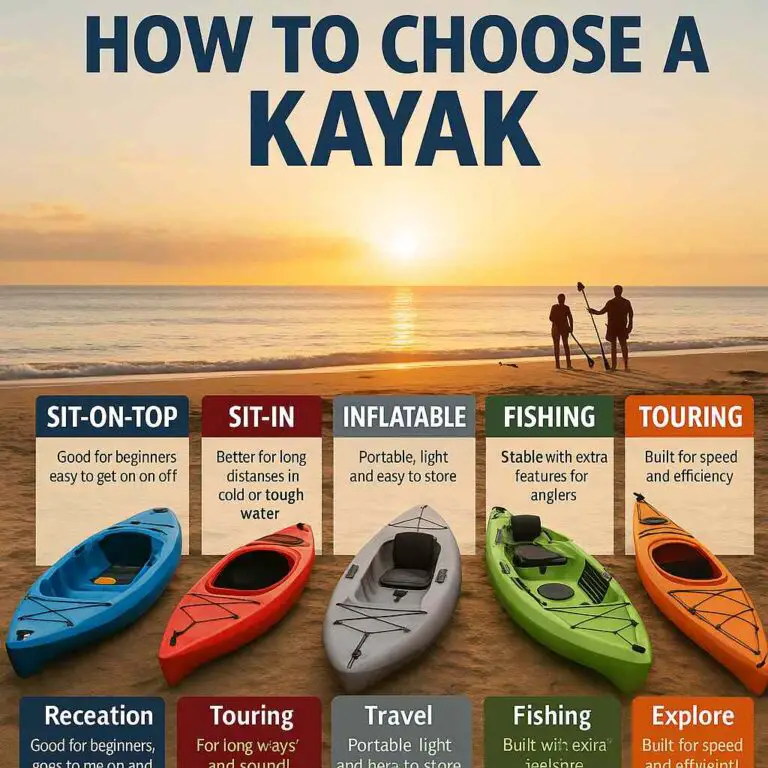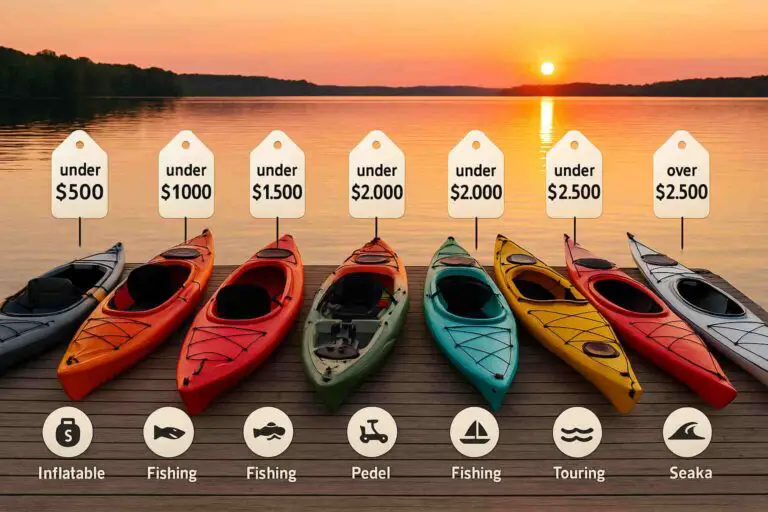Inflatable kayaks have gained tremendous popularity in recent years, raising the question, ‘Are inflatable kayaks any good?’ As someone who has had a long and enjoyable journey with inflatable kayaks, I can confidently say that they are a fantastic option for outdoor enthusiasts. My experiences have taught me several valuable lessons and given me practical insights into owning and using inflatable kayaks.
The Rise of Inflatable Kayaks
Inflatable kayaks have come a long way from their humble beginnings as pool toys. They’ve evolved into robust watercraft designed for various water adventures, including whitewater rafting, lake cruising, and ocean exploration. Their newfound popularity can be attributed to several factors:
Portability and Convenience: I’ve personally experienced the incredible portability of inflatable kayaks. They can be deflated, rolled up, and stored in a compact bag, making them an excellent choice for adventurers with limited storage space or those who don’t own a roof rack-equipped vehicle.
Affordability: Traditional hard-shell kayaks can be expensive. In contrast, inflatable kayaks offer a cost-effective alternative without compromising on quality.
Durability: Modern inflatable kayaks are constructed using robust materials that can withstand punctures and abrasions, ensuring longevity and safety on the water.
Versatility: Inflatable kayaks are available in various designs, from solo to tandem options and specialized models for specific water activities.
Construction of Inflatable Kayaks
To understand if inflatable kayaks are any good, it’s essential to examine their construction. Inflatable kayaks are typically made of three main materials:
PVC (Polyvinyl Chloride): Most entry-level inflatable kayaks are constructed from PVC. While it’s durable, it can be susceptible to UV damage and is not as puncture-resistant as some other materials.
Hypalon or CSM (Chlorosulfonated Polyethylene): High-end inflatable kayaks often use Hypalon or CSM. These materials are UV-resistant and provide superior durability, making them ideal for long-lasting watercraft.
Drop-Stitch Fabric: For inflatable kayaks designed for high-performance activities like whitewater rafting, drop-stitch technology is employed. It involves thousands of interconnected threads, resulting in a rigid and stable kayak that can handle rough waters.
Advantages of Inflatable Kayaks
Now that we’ve looked at their construction let’s delve into the advantages of inflatable kayaks
Portability: I can attest to the ease of transporting inflatable kayaks. They can be transported in the trunk of your car or even checked as luggage when traveling by plane, offering unparalleled convenience.
Storage: They can be stored in a closet or under your bed when not in use, eliminating the need for dedicated storage space or a roof rack.
Stability: Many inflatable kayaks offer excellent stability, making them suitable for beginners and those seeking a relaxing day on calm waters.
Weight: They are significantly lighter than hard-shell kayaks, making them easier to handle both on and off the water.
Puncture Resistance: Quality inflatable kayaks are built to resist punctures, and even if they do get a hole, they can often be easily repaired with a patch kit.
Affordability: Inflatable kayaks are generally more affordable than their hard-shell counterparts, making them accessible to a wider range of people.
Disadvantages of Inflatable Kayaks
While inflatable kayaks offer numerous benefits, it’s important to acknowledge their limitations:
Performance: Inflatable kayaks may not perform as well as hard-shell kayaks in terms of speed and tracking, especially in choppy or windy conditions.
Setup Time: You’ll need to inflate and deflate the kayak each time you use it, which can be time-consuming compared to just placing a hard-shell kayak in the water.
Weight Limit: Inflatable kayaks often have weight limits, so if you plan to carry a lot of gear or have multiple passengers, you may need a larger model.
Initial Stability: While they offer great stability once on the water, some inflatable kayaks may feel less stable when you first get in due to their buoyant nature.
Types of Inflatable Kayaks
1. Recreational Inflatable Kayaks
Recreational inflatable kayaks are designed for calm waters, such as lakes and slow-moving rivers. They are typically the most affordable option and are perfect for beginners and casual kayakers. These kayaks prioritize stability and ease of use over speed and performance.
2. Touring Inflatable Kayaks
Touring inflatable kayaks are built for longer trips and more challenging waters. They often feature sleek designs for improved speed and tracking. Touring kayaks are a great choice for those who want to explore larger bodies of water or plan multi-day excursions.
3. Whitewater Inflatable Kayaks
Whitewater inflatable kayaks are specifically designed to handle the adrenaline-pumping rush of rapids and fast-flowing rivers. They are built with reinforced materials and have a more rigid structure to withstand the rigors of whitewater kayaking.
4. Fishing Inflatable Kayaks
Fishing inflatable kayaks cater to anglers who want to combine their love of fishing with kayaking. They often come equipped with fishing-specific accessories like rod holders, tackle storage, and stable platforms for casting.
Each type of inflatable kayak serves a different purpose, so it’s crucial to choose the one that aligns with your intended use and skill level.
Detailed Comparison: Inflatable vs. Hardshell Kayaks
Transportation: Inflatable kayaks are far more convenient for those without roof racks or large vehicles. Hardshell kayaks require specialized equipment for transportation.
Storage: Inflatable kayaks win here, as they can be stored in small spaces when deflated, while hardshell kayaks demand ample storage space.
Performance: Hardshell kayaks generally outperform inflatables in terms of speed and tracking, making them better for advanced kayakers or long-distance trips. Inflatables are more stable but may not be as fast.
Cost: Inflatables often have a higher upfront cost but can be more cost-effective in the long term due to the savings on transportation and storage.
Choosing the Right Inflatable Kayak
To ensure your inflatable kayak meets your specific needs, it’s crucial to consider the following factors:
Intended Use: Are you planning on leisurely paddling on calm lakes, navigating whitewater rapids, or exploring the open ocean? The type of kayaking you intend to do will dictate the kayak model you should choose.
Size and Capacity: Determine whether you need a solo or tandem kayak and check the weight capacity to accommodate passengers and gear comfortably.
Material: Select a kayak constructed from high-quality material, preferably Hypalon or CSM if you seek longevity and durability.
Inflation Method: Some kayaks have multiple air chambers for added safety. Choose a model with a reliable inflation method, such as a hand pump, foot pump, or even an electric pump for convenience.
Accessories: Consider additional features like adjustable seats, storage compartments, and fishing rod holders if they align with your intended use.
Inflatable Kayak Brands and Models
To help you make an informed decision, here are some popular inflatable kayak brands and models known for their quality and performance:
Recommended Brands Advanced Elements: Known for their durable and well-designed inflatable kayaks.
- Sea Eagle: Offers a wide range of inflatable kayaks suitable for various activities and skill levels.
- AIRE: Excellent for whitewater enthusiasts, they produce high-quality inflatable kayaks.
Brands to Avoid
- Off-brand or generic inflatables: While they may be cheaper, they often lack the durability and support offered by reputable brands.
- Intex: Generally designed for recreational use, these kayaks may not hold up well in more demanding conditions.
Maintaining Your Inflatable Kayak
To ensure your inflatable kayak remains in good condition and lasts for years, follow these maintenance tips
- Clean and Dry: After each use, rinse your kayak with freshwater and let it dry thoroughly before storing it to prevent mold and mildew growth.
- Inspect for Damage: Regularly check for any punctures, tears, or damage to the kayak’s surface. Repair any issues promptly using a patch kit.
- Store Properly: Store your kayak in a cool, dry place away from direct sunlight and extreme temperatures to prolong its lifespan.
- Avoid Overinflation: Be mindful not to overinflate your kayak, as this can put excessive strain on the seams and materials.
- Use a Pump: Invest in a quality pump for easy and efficient inflation and deflation.
Drying and Maintenance Challenges
Drying inflatable kayaks can be a challenge, especially if they have multiple air chambers. To efficiently dry them:
- Use a towel: After deflating, wipe down the kayak with a towel to remove excess moisture.
- Dry in the sun: Lay the kayak out in the sun, ensuring that all areas receive direct sunlight to prevent mold growth.
- Use a kayak stand: Invest in a kayak stand or create a DIY solution to keep your kayak elevated for better airflow during drying.
Importance of Valves and Pumps
Valves and pumps play a crucial role in the usability of inflatable kayaks. Look for
- User-friendly valves: Twist-lock valves are easy to use and prevent air leaks.
- High-capacity pumps: A double-action hand pump or an electric pump can save you time and effort during inflation and deflation.
- Pressure gauge: Ensure your pump has a pressure gauge to prevent over-inflation.
Optimal Storage Conditions for Inflatable Kayaks
To extend the lifespan of your inflatable kayak, follow these storage tips
- Avoid sharp objects: Keep your kayak away from sharp objects to prevent punctures or tears.
- Temperature control: Store it in a cool, dry place to avoid extreme heat or cold, which can affect the material.
- Deflate partially: When not in use, partially deflate the kayak to relieve pressure on the seams and valves.
The Rise of Drop Stitch Technology
Drop stitch technology has revolutionized inflatable kayaks. It involves thousands of tiny threads within the inflatable chamber, creating a rigid structure that greatly enhances performance. Kayaks using drop stitch technology are more rigid and can closely match the performance of hardshell kayaks in terms of speed and tracking.
Cost-Effectiveness and Value Assessment
The cost-effectiveness of owning an inflatable kayak depends on your usage. If you kayak frequently and need the convenience of transport and storage, an inflatable kayak is a sound investment. Calculate the total cost of ownership, including initial purchase, maintenance, and storage solutions, to compare with renting or buying a hardshell kayak.
Choosing Between Single vs. Tandem Kayaks and Comparing with SUPs
When choosing between single and tandem inflatable kayaks, consider:
Activity: Singles are more versatile for solo adventures, while tandems are ideal for paddling with a partner.
Stability: Tandems offer greater stability due to their wider design.
Speed: Singles are typically faster, but tandems provide more power for longer distances.
Storage: Tandems can be more challenging to transport and store due to their size.
Comparing inflatable kayaks with stand-up paddleboards (SUPs)
Stability: SUPs are generally more stable due to their wider platform, making them suitable for beginners.
Speed: Kayaks are usually faster due to their streamlined design.
Versatility: Kayaks offer more seating options, making them better for varied activities like fishing or touring.
Transportation: SUPs are more compact and easier to carry, while kayaks may require additional equipment.
Ultimately, your choice between single/tandem kayaks and SUPs should align with your intended use and personal preferences. Each has its unique advantages, and trying both can help you decide which suits you best.
Frequently Asked Questions (FAQs)
Are inflatable kayaks safe?
Yes, inflatable kayaks are generally safe when used as intended. They are designed with safety in mind and are suitable for various skill levels. However, it’s essential to follow safety guidelines, wear a personal flotation device (PFD), and be aware of your skill level and the conditions of the water you are paddling in.
How long do inflatable kayaks last?
The lifespan of an inflatable kayak depends on factors such as material quality, maintenance, and usage. With proper care and occasional repairs, many inflatable kayaks can last for 5-10 years or even longer.
Can inflatable kayaks handle rapids?
There are inflatable kayaks specifically designed for whitewater and rapids. These models are built with reinforced materials and construction to withstand the challenges of fast-moving water. However, not all inflatable kayaks are suitable for whitewater, so it’s crucial to choose the right type for your intended use.
Are they suitable for beginners?
Yes, inflatable kayaks are suitable for beginners, especially recreational models. They offer stability and ease of use, making them an excellent choice for those new to kayaking. However, beginners should always wear a PFD and take a basic kayaking safety course.
What accessories do I need?
The essential accessories for kayaking include a paddle, PFD, and a pump for inflating your kayak. Depending on your specific use, you may also want to consider additional accessories such as a dry bag, kayak cart, and safety gear.
Conclusion
In conclusion, inflatable kayaks are indeed a good choice for many enthusiasts. They offer excellent portability and ease of storage, making them ideal for those with limited space or who enjoy traveling to different paddling locations.
While they might not match the speed and tracking precision of hard-shell kayaks, modern inflatable kayaks are surprisingly durable, stable, and suitable for a variety of water conditions. Their affordability also makes them an attractive option for beginners and those on a budget. Overall, inflatable kayaks provide a convenient and enjoyable way to explore waterways for recreational paddlers and adventure seekers alike.
Remember to follow proper maintenance procedures to ensure your inflatable kayak remains in top condition and provides you with countless memorable adventures on the water. So, the next time someone asks, “Are inflatable kayaks any good?” you can confidently say, Absolutely!
Here’s another question frequently asked: Can you roll an inflatable kayak? find out the answer right here.




